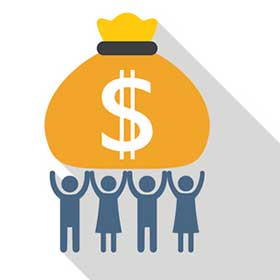Here’s the Difference between Fiscal Policy and Monetary Policy
Learning the difference between fiscal policy and monetary policy is essential to understanding who does what when it comes to the federal government and the Federal Reserve. The short answer is that the U.S. Congress and the administration conduct fiscal policy, while the Federal Reserve conducts monetary policy.
Both types of policy can have a significant effect on our everyday lives, but the lines between them can seem blurry to the average consumer. Let’s sort it out.
Monetary Policy Is the Federal Reserve’s Role

The word “monetary” means having to do with money. And monetary policy is the wheelhouse of a central bank.
Monetary policy refers to actions that central banks take to pursue objectives such as price stability, maximum employment and stable economic growth. When we say pursue, we’re talking on a big scale—a macroeconomic scale.
In the United States, the Federal Reserve is the central bank. (It’s often called the Fed, for short.) The U.S. Congress has established maximum employment and price stability as the macroeconomic objectives for the Fed to work toward. This is often referred to as the Federal Reserve's dual mandate.
How does the Federal Reserve conduct monetary policy? It can do so by influencing the supply of money in the economy, as well as influencing interest rates in markets, explained St. Louis Fed economist David Wheelock in a recent podcast.
To influence the money supply and interest rates, the Fed has various tools. Some key ones include:
- Open market operations
- The discount rate
- Reserve requirements
- Interest on reserve balances
Fiscal Policy Is the Federal Government’s Role
The word “fiscal” relates to public treasury or revenues. Fiscal policy is a broad term used to refer to the tax and spending policies of the federal government.
“Fiscal policy refers to government spending and taxing decisions,” Wheelock said. “Economics textbooks and various economic models usually think of fiscal policy in terms of the size of the government budget deficit, the difference between what the government spends and its revenue.”
As stated by the Federal Reserve Board of Governors, fiscal policy decisions are determined by Congress and the administration; the Fed does not play a role in determining fiscal policy.

An Example of Both: The Response to the Financial Crisis
Like driving a car, both monetary and fiscal policy provide ways to accelerate or pump the brakes on the economy. The financial crisis that took place from 2007 to 2009—and the Great Recession that followed—drew a multipronged response from both the Federal Reserve and the U.S. government.
Monetary Policy
Remember those tools we mentioned? The first, open market operations, refers to the Fed’s ability to buy and sell government securities in the open market. Purchasing securities—known as “easing” or “expansionary” monetary policy—increases the amount of reserve funds that banks have available to lend, which puts downward pressure on the federal funds rate.
Expansionary monetary policy took place as part of the Fed’s response to the financial crisis. As the crisis emerged, the Fed implemented a series of programs to provide short-term liquidity while purchasing large amounts of U.S. Treasury and mortgage-backed securities to put downward pressure on longer-term interest rates and ease overall financial conditions.
Fiscal Policy
Meanwhile, the U.S. Treasury and the executive and legislative branches of the federal government took swift action as well. A deluge of new programs—the Economic Stimulus Act, the Housing and Economic Recovery Act, the Emergency Economic Stabilization Act and others—were enacted, pumping billions of dollars into the economy to not only prevent further crisis, but also stimulate spending from businesses and consumers.
The actions of the Federal Reserve and the federal government ultimately had the same intended purpose: to lessen the crisis and to promote a stable economy and financial system. But they illustrate the differences between monetary policy and fiscal policy.
Federal Reserve Independence: Why Boundaries Matter
If monetary policy and fiscal policy can work toward similar goals, why worry about keeping those policies separate? The answer lies within one of the Fed’s most important and timeless tenets—independence.
For the Fed, achieving its dual mandate of price stability and maximum sustainable employment requires a longer-term perspective, given the time lag between monetary policy actions and results, the Federal Reserve Board explains. Wheelock noted it’s important that the Fed be shielded from short-term political pressures.
With very rare exceptions, he said, there’s never been coordination between monetary and fiscal policy. “The Fed makes its own decisions with regard to the economy. It takes into consideration all kinds of information, including the stance of government’s fiscal policy.”
“But, basically,” he continued, “the Fed is looking at indicators of expected inflation, the state of the business cycle, whether we’re at full employment or whether there are a lot of unemployed resources, and it tries to look at all sorts of factors when it sets monetary policy. So in that sense there’s no direct coordination.”
Additional Resources
- Podcast: Monetary Policy Minutes: What Is Monetary Policy?
- In Plain English: The Fed Implements Monetary Policy
This blog explains everyday economics and the Fed, while also spotlighting St. Louis Fed people and programs. Views expressed are not necessarily those of the St. Louis Fed or Federal Reserve System.
Email Us


